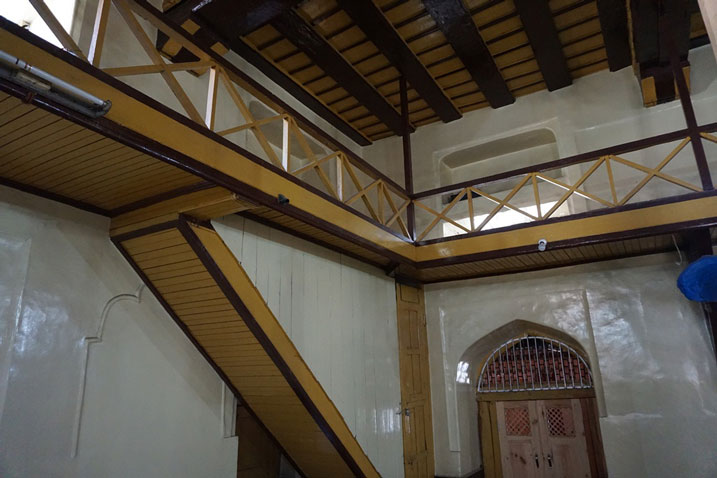Persian Glory: This Forgotten Sanctum Is Kashmir’s First Khanqah?

Arif Nazir is a Staff Writer at the Mountain Ink.



 +7
+7 Persian Glory: This Forgotten Sanctum Is Kashmir’s First Khanqah?
Persian Glory: This Forgotten Sanctum Is Kashmir’s First Khanqah?
Persian Glory: This Forgotten Sanctum Is Kashmir’s First Khanqah?
Persian Glory: This Forgotten Sanctum Is Kashmir’s First Khanqah?
Persian Glory: This Forgotten Sanctum Is Kashmir’s First Khanqah?
Persian Glory: This Forgotten Sanctum Is Kashmir’s First Khanqah?
Persian Glory: This Forgotten Sanctum Is Kashmir’s First Khanqah?
Persian Glory: This Forgotten Sanctum Is Kashmir’s First Khanqah?
Persian Glory: This Forgotten Sanctum Is Kashmir’s First Khanqah?
Persian Glory: This Forgotten Sanctum Is Kashmir’s First Khanqah?
Kashmir’s Persian connection might’ve elapsed from public memory amid the blitz of the distorted narrative over the years, but a sanctum sanctorum in old Srinagar is still making these ties as obvious as it was back in the reformer’s time.
A turret rising from a rusty pyramid-shaped rooftop in downtown’s defiant pocket populated by polemic protagonists of the past is a spectacular sight.
But the edifice—one of the striking symbols of Kashmir’s transformed times—is lost in waning oral legends and relentless institutional shift.
Some elders on shop-fronts have a stark introduction about the place. They called it Mullah Hatta—the abode of scholars—now known as Mallaratta.

Before the jola-slinging comrades would parade their bookish worldview in the valley of saints, the unassuming men-of-letters had long traversed these lanes for the quest of knowledge.
But today, unlike its recent bunkered past and smoked alleys, the bustling pocket is as baffling as the sweeping stillness in the region.
Support Our Journalism
You are reading this because you value quality and serious journalism.
But, serious journalism needs serious support. We need readers like you to support us and pay for making quality and independent journalism more vibrant.

Chirpy cart-pullers, blaring loudspeakers of the Jamia Masjid, and chitchats on tobacco outlets and grocery stores make it a typical old city neighbourhood, known for its buoyant bustle.

But inside the sanctum—bereft of yesteryears’ mystics and their meditative silence—the magnificent architecture is fast heading into oblivion. Yet in resemblance, Khanqah-e-Andrabia looks like a clone of Jamia Masjid.
Like the grand mosque of Kashmir, bright yellow pillars raise high from the stone frames to the rooftops.
The structure has been constructed in a Persian manner with the Indo- Saracenic style of architecture.

Many native storytellers—well-versed with the sanctum saga—have either faded or shifted.
What remains behind is the loose thread of the revered place which many say could be Kashmir’s first Sufi school, called Khanqah in Persian.

The legend starts with the rise of the Shah Mir dynasty and the beginning of the Sultan era — the epoch when Kashmir opened its doors for the Muslim world.
The subsequent scholar-skill storm would ensure a massive faithful transformation and rise of golden hands in the valley.

As Kashmir embraced Central Asian influences in every way possible, new symbols and structures became a part of life. One of them would soon come up at Mir Mohalla of Mallaratta.
It was established by a close kin of the saint—reformer—who would spearhead one of the biggest and bloodless faithful movements in the world.


After Mir Syed Ali Hamdani’s departure from the valley, many of his scholars—Sadaats—stayed back to spread and sustain “the religion of peace” in the valley.
Among them was his nephew, Syed Ahmad Andrabi — the scholar who had migrated from Andrab, a small valley located in the southern part of Baghlan Afghanistan.
His progeny is called Andrabi Syed, reflecting their geographical roots.
“Our forefather Syed Ahmad Andrabi laid the foundation of this place when he arrived as one of the Sadaats of Shah-i-Hamdan [R.A] in the valley,” says Wajee Andrabi, a caretaker of the ancestral Khanqah.
“Its parts included a Hujra where they would rest, a Darassgah where students were taught the holy Quran and Hadees, and a space for prayers.”

Terming Khanqah-e-Andrabia as the first Khanqah of the valley, Wajee Andrabi argues the history has remained silent of the place’s contribution to the Kashmiri society.
Since Khanqah-e-Andrabia like Jamia Masjid and Khanqah-e-Maula was constructed during Sultan Sikander’s reign, Zareef Ahmad Zareef doesn’t negate the Wajee’s claim.
“Although Khankah-e-Maula’s role is central in the unfolding of watershed events in history,” Zareef, a Kashmir chronicler, says, “but Khankah-e-Andrabia has also played its part in the sweeping change in the valley.”

During Budshah’s rule, a mosque and seminary were added to the sanctum.
But after passing through generations of caretakers, the sanctum got its inheritor in word and deed in the form of Syed Mir Mirak Andrabi (1515 –1582 AD), Syed Ahmad Andrabi’s great-grandson.
“A saint whose spiritual stature would attract devotees from miles and far places, Syed Mirak Andrabi lived up to his great grandfather Syed Ahmad Andrabi’s reputation,” continues Wajee Andrabi. “His resting place is now a part of the structure.”

In the sunny lawn of the Khanqah, a middle-aged man has arrived all the way from Sopore to offer prayers.
“Praying here isn’t just peaceful, but as fascinating as it would feel to be at some historic place in Central Asia,” says Adil Dar, a Khanqah regular from the north.
Dar isn’t the only one to travel miles to be at the sanctum known for shaping the idea of faith in the valley.
For his mystic tribe, Persia might be far away, but little Persia isn’t.
To help us strengthen the tradition of quality reading and writing, we need allies like YOU. Subscribe to us.
Mountain Ink is now on Telegram. Subscribe here.
Become Our Ally
To help us strengthen the tradition of quality reading and writing, we need allies like YOU. Subscribe to us.


































